
Psychology
Neural, genetic, and cognitive signatures of creativity
C. Liu, K. Zhuang, et al.
This innovative study explores the multifaceted nature of creativity through divergent thinking (DT). By combining fMRI data, cognitive decoding, and genetic insights, the research reveals a complex interplay within brain networks associated with DT. The authors Cheng Liu, Kaixiang Zhuang, Daniel C. Zeitlen, Qunlin Chen, Xueyang Wang, Qiuyang Feng, Roger E. Beaty, and Jiang Qiu uncover intriguing links between creativity and neurotransmitter dynamics.
Playback language: English
Related Publications
Explore these studies to deepen your understanding of the subject.







